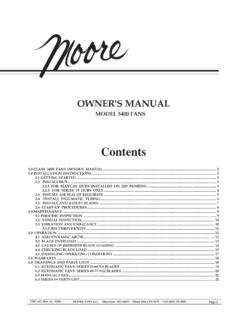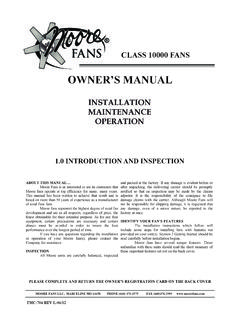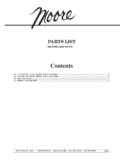Transcription of HOW TO SELECT A LOW NOISE FAN - Moore Fans
1 HOW TO SELECT A LOW NOISE FANThe total sound power produced by the fan can be calculated by the empirical formula below. Theformula yields the Sound Power Level (PWL) in decibels. Logs are to the base 10:Fan AFan B(No NOISE Concern)(Low NOISE Fan)Hub Series:4060 Number of Blades::47 RPM::318200 Tip Speed FPM:12,0007,500m/ (dBA) = + 30 Log VT + 10 Log HPWhere: VT = Fan tip speed in ft/min x 10-3= P x DIA. x RPM/1000HP = Input Fan Horsepower (Not motor horsepower)The formula is given here to demonstrate the fact that the tip speed of the blades is by far thestrongest indicator of the NOISE a fan will produce. To SELECT a low NOISE fan, therefore, it is mosteffective to reduce the tip speed by lowering the RPM which can be done by increasing the number the characteristics of the two fans shown in the table below. Each has been selected toperform identical duties.
2 They are 12 ft (3658 mm) diameter fans , handling 100 o F air at sea level,delivering 120,000 ACFM ( m3/sec) at " ( mm) static pressure. Fan A is a suitableselection for an application where NOISE level is of no concern and Fan B is selected for its low low NOISE fan is over 6 dB quieter than Fan A. In linear sound power terms (watts) thiscorresponds to less than 1/4 of the NOISE emanating from the from the low- NOISE fan could be further reduced by specifying the new low- NOISE VT blades are provided with aerodynamic winglets added at the tips, an economical way to reducenoise 2 to 3 dB over standard blades in a typical low NOISE fan. Winglets at the blade tip decrease thetip vortex which occurs as air spills off the tip from the high to the low pressure side of the blade,thus lowering the NOISE are some limitations to consider in lowering fan RPM.
3 If the axial velocity of the discharged airis too low compared to the rotational velocity of the air, flow will tend to break down and inefficiencywill result. Note in the above example that the fan series was increased from 40 (40" diameter hub) to60 (60" diameter hub). The increase in hub size results in higher velocity due to the decrease in freefan area and therefor prevents flow breakdown near the is conducting ongoing NOISE research with the aim of providing ever more quiet fans . Formore information, please Contact Moore .



